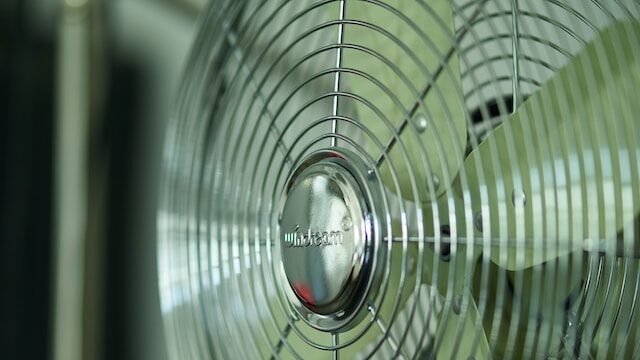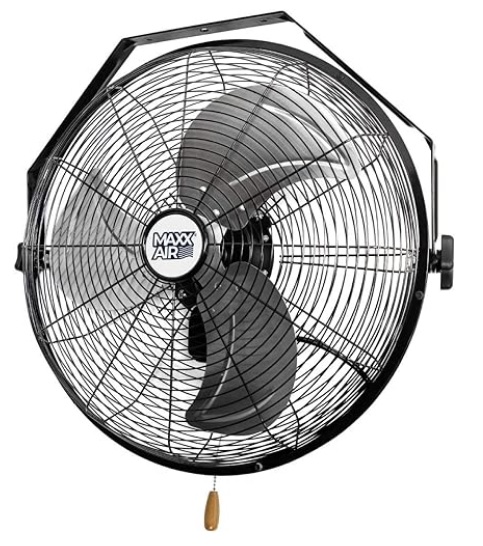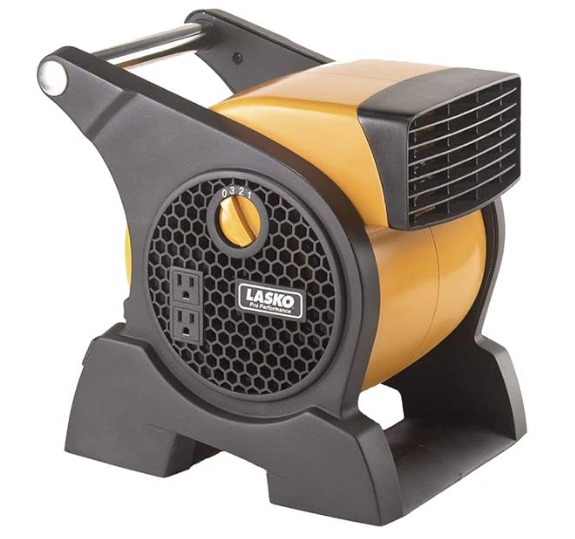Garage Fan 101: Selection, Installation, and Maintenance
A garage fan is specifically designed to promote air circulation, reduce excess humidity, and improve the overall conditions of your garage space. With their robust build, varying designs, and multiple functionalities, they cater to an environment that is often both a workspace and a storage area. Garages often lack the adequate ventilation that the rest of our homes benefit from. They can be damp, dark, and lacking circulation, especially if they’re detached from the main house. This is where garage fans step in.
Why Consider a Garage Fan?
Now, you might be wondering, “Do I really need a garage fan?” I mean, isn’t it just an extra piece of equipment taking up space?
Protecting Your Valuables
Your garage often houses more than just your car. Tools, bicycles, camping gear, maybe even a collection of vintage items; all these valuables need protection. Moist environments can lead to rust on tools and degrade other stored items over time. With a garage fan, you help decrease moisture and, as a result, prolong the life of everything stored there.
Comfort While Working
Many of us use the garage as a workspace for DIY projects, car repairs, or other hands-on activities. It’s no fun trying to focus on a task when you’re battling oppressive heat or chilling cold. A garage fan can help regulate the temperature, making your garage a more comfortable place to work.
Ventilation and Air Circulation
A stagnant garage can become a breeding ground for mold and mildew. Also, if you’re using paints, solvents, or any other chemicals, those fumes need to go somewhere. A garage fan ensures that fresh air circulates, pushing out any potentially harmful fumes and making sure you’re not breathing in anything you shouldn’t.

Features to Look For
When choosing a garage fan, there are a bunch of features to consider so you can select what caters to your needs. Let’s explore some of these key aspects:
Size and Power
When we talk about size, it doesn’t necessarily mean that the biggest fan out there is the best one for your garage. Instead, you should look for a fan size that aligns with the size of your garage. A compact garage might become a wind tunnel with an excessively large fan, while a tiny fan could prove ineffective in a spacious area.
Power, on the other hand, refers to the fan’s ability to move air efficiently. Always check the CFM (Cubic Feet per Minute) rating of a fan. This metric gives you an idea of the volume of air the fan can move in a minute. A higher CFM usually means better airflow, but balance it with the size of your space.
Noise Level
Nobody likes working in a noisy environment, right? While some noise from a fan is inevitable, there’s a massive difference between a gentle hum and a roaring equipment. Manufacturers typically provide a noise level rating for their products, measured in decibels (dB). Lower dB ratings indicate quieter operation. It’s always a good idea to opt for fans that strike a balance between effective air circulation and low noise generation. After all, a quiet workspace is a peaceful one!
Energy Efficiency
While we all want our garages to be comfortable, nobody wants a shocker of an electricity bill at the end of the month. Efficient fans do their job without consuming excessive power. Look out for fans with energy-saving features or those rated by energy standards like ENERGY STAR. In the long run, these fans might cost a bit more upfront, but they’ll save you money on your utility bills. And hey, being energy-conscious is not just good for your pocket but the planet too!
Types of Garage Fans
Garage fans come in various types, each with its unique set of advantages. To help you make an informed decision, let’s walk through the primary categories.
Wall-Mounted Fans
Wall-mounted fans, as the name suggests, are attached directly to the wall. One of the primary benefits here is space efficiency. With your fan up on the wall, you’re not losing any valuable floor space. This makes them perfect for smaller garages or spaces crowded with tools and equipment. Another advantage is that they can be positioned at an angle that directs airflow across a broader area. Most wall-mounted fans come with adjustable heads, allowing you to steer the breeze exactly where you want it. And since they’re up on the wall, there’s little risk of them being knocked over or obstructed by items moving around the garage.
Product Recommendation: Maxx Air Wall Mount Fan

Why I Recommend It: Maxx Air is a trusted brand when it comes to fans, and this particular model boasts an impressive number of positive reviews. Users love its durability and powerful airflow.
Standout Features:
Adjustable Tilt: Direct the airflow exactly where you need it.
Durable Construction: Built to last with powder-coated steel.
Multiple Speed Settings: Tailor the airflow to your liking.
Floor Fans
For those who like flexibility, floor fans are a good choice. These fans sit on the ground and can be easily moved from one spot to another. Planning to work at one end of the garage today and another end tomorrow? No problem, just pick up your floor fan and relocate. They’re particularly useful for directing airflow at a specific point or for drying wet patches on the floor. And with their sturdy bases, they can handle the occasional bump or nudge without toppling over.
Product Recommendation: Lasko High Velocity Pro-Performance Pivoting Utility Fan

Why I Recommend It: Lasko’s utility fan is a favorite among garage enthusiasts. The compact design combined with high velocity makes it a hit for many. Its high ratings and rave reviews emphasize its efficiency and power.
Standout Features:
Pivoting Head: Directs the breeze in multiple directions.
Integrated Power Outlets: You can plug in tools directly into the fan, a bonus for any workspace!
Easy-Grip Handle: For hassle-free relocation.
Ceiling Fans
Now, ceiling fans might seem a bit unconventional for a garage, but they’re gaining popularity—and for good reason. Ceiling fans provide consistent, overhead airflow that covers a significant area. They’re excellent for ensuring general ventilation throughout the entire garage. Modern ceiling fans come with varied designs and finishes, so you can choose one that complements the aesthetics of your garage. And just like wall-mounted fans, they don’t take up any floor space, making them a great choice for garages of all sizes.
Product Recommendation: Hunter Fan 51180 Kennicott 52 inch Ceiling Fan

Why I Recommend It: Hunter is a renowned name in the world of ceiling fans. This model is designed for both indoor and outdoor use, making it resilient enough for a garage environment. Its stellar reviews underline its performance and aesthetic appeal.
Standout Features:
Weatherproof: Ensures the fan remains in top condition even in changing environmental conditions.
Whisper Quiet Performance: No annoying hums or buzzes, just smooth airflow.
Surespeed Guarantee: Promises 33% higher air velocity while maintaining quiet, wobble-free performance.
Installing Your Fan
Choosing the right spot in your garage is essential for fan installation. For wall-mounted fans, a location that allows for optimal airflow is ideal. Ceiling fans should be centrally placed, while floor fans need adequate surrounding space for effective circulation. Always prioritize safety by turning off any electrical circuits in the area where you’ll be working, and it’s wise to double-check with a circuit tester. Though many might overlook it, thoroughly reading the manual is crucial as different models have distinct installation procedures. When installing, especially for wall or ceiling variants, ensure the fan is securely anchored, typically to wall studs or ceiling joists. After the installation, do a quick test run to check for any unusual sounds or vibrations, and if you’re ever uncertain during the process, don’t hesitate to consult a professional.
Maintenance Tips
To ensure the longevity and efficient performance of your garage fan, regular upkeep is essential. Dust accumulation is a common issue, so it’s good practice to wipe down your fan frequently. For those hard-to-reach ceiling fans, consider using a vacuum with a brush attachment. Periodically inspecting the fan’s screws and other fasteners is important as they can loosen over time. Fans with motors might require occasional lubrication, so always refer to the user manual for specific guidelines. On the off chance you observe your ceiling fan wobbling, it might be out of balance; fortunately, balancing kits are readily available to address this. Unusual noises from your fan should always be monitored as they could indicate potential issues. Remember to replace any worn-out parts, like pull chains or knobs, and aim for a comprehensive yearly check-up, which involves a deep clean, inspecting for wear and tear, and ensuring all components function correctly.
Conclusion
Garage fans enhance the comfort, safety, and longevity of our garage workspace and tools. From wall-mounted, floor, to ceiling variants, each type offers unique benefits, tailored to the specifics of your garage. While installation needs a careful approach, ongoing maintenance ensures your fan serves you effectively for years. When selecting a fan, factors like size, power, noise level, and energy efficiency should be taken into consideration. Investing time in choosing and caring for your garage fan will undeniably result in a more pleasant and functional garage environment.
FAQs
1. What’s the significance of the CFM rating on a fan?
CFM (Cubic Feet per Minute) indicates the volume of air the fan can move in a minute. A higher CFM typically means better airflow.
2. Are there fans specifically designed for garages?
Yes, garage fans are crafted to cater to the unique needs of garages, considering factors like moisture, size, and the requirement for ventilation.
3. How often should I clean or maintain my garage fan?
It’s recommended to clean your fan regularly, at least once a month. A thorough maintenance check should be done annually.
4. Is it safe to install a fan by myself?
While many enthusiasts do install fans on their own, if you’re unfamiliar with electrical setups or the process, consulting a professional is advised.
5. Does a larger fan always mean better cooling?
Not necessarily. The ideal fan size and power depend on your garage’s size and layout. An excessively large fan in a small space might be counterproductive.





Comments are closed.